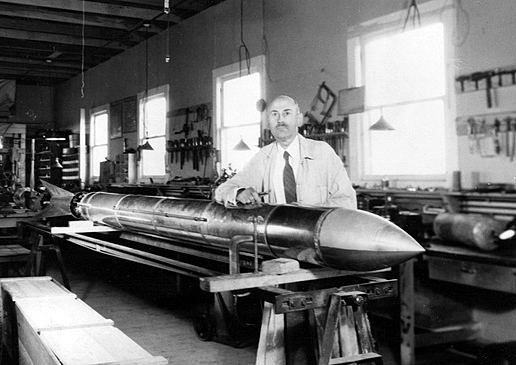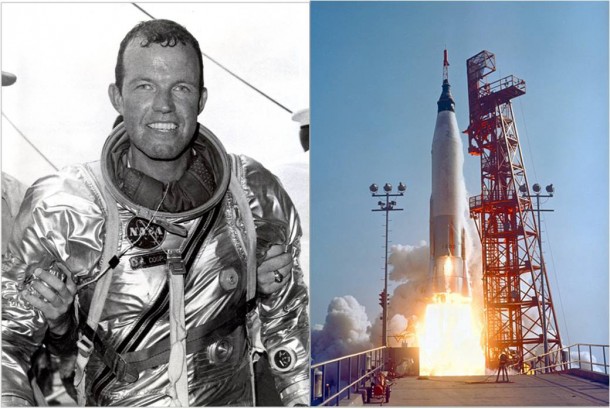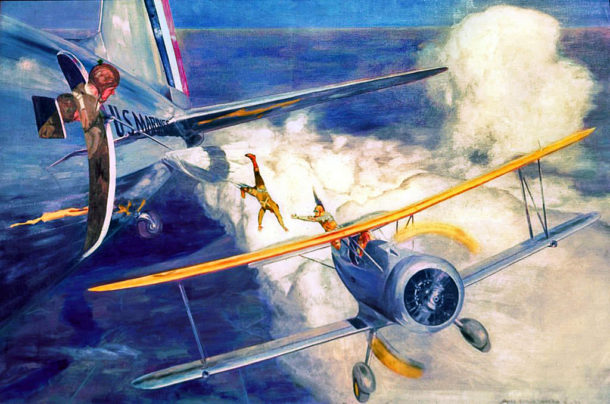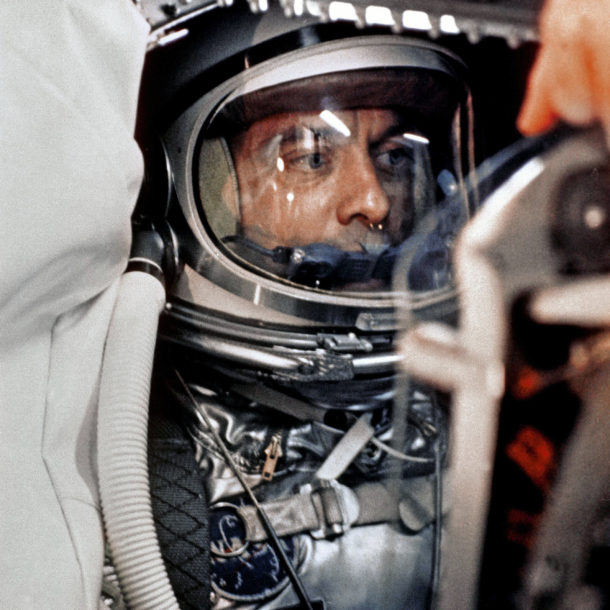
Eighty-five years ago this month, pioneering rocket scientist Robert H. Goddard and staff fired a liquid-fueled rocket to a record altitude of 7,500 feet above ground level. The record-setting flight took place at Roswell, New Mexico.
Robert Hutchings Goddard was born in Worcester, Massachusetts on Thursday, 05 October 1882. He was enamored with flight, pyrotechnics, rockets and science fiction from an early age. By the time he was 17, Goddard knew that his life’s work would combine all of these interests.
Goddard was a sickly youth, but spent his well moments as a voracious reader of all manner of science-oriented literature. He graduated in 1904 from South High School in Worcester as the valedictorian of his class. He matriculated at Worcester Polytechnic and graduated with a Bachelor of Science degree in physics in 1908. A Master of Science degree and Ph.D. from Worcester’s Clark University followed in 1910 and 1911, respectively.
Goddard spent the next eight years of his life working on numerous propulsion and rocket-related projects. Then, in 1919, he published his now-famous scientific treatise entitled A Method of Reaching Extreme Altitudes. In that paper, the press glommed on to Goddard’s passing mention that a multi-staged rocket could conceivably fly all the way to the Moon.
Goddard was roundly ridiculed for his fanciful prognostications about Moon flight. The New York Times was especially derogatory in its estimation of Goddard’s ideas and accused him of junk science. A Times editorial even criticized Goddard for his ”misconception” that a rocket could produce thrust in the vacuum of space.
Even the U.S. government largely ignored Goddard. This scornful treatment to which Goddard was subject hurt him profoundly. So much so that he spent the remainder of his life alienated from the denizens of the press as well as the dolts of governmental employ.
Despite the blow to his professional reputation, Goddard resolutely pressed on with his rocket research. Indeed, after more that five years of intense development effort, Goddard and his staff launched the first liquid-fueled rocket on Tuesday, 16 March 1926 in Auburn, Massachusetts. The flight duration was short (2.5 seconds) and the peak altitude tiny (41 feet), but Goddard proved that liquid rocket propulsion was feasible.
Goddard’s liquid-fueled rocket testing would ultimately lead him from the countryside of New England to the desert of the Great South West. With financial support from Harry Guggenheim and the public backing of Charles Lindbergh, Goddard transferred his testing activities to Roswell, New Mexico in 1930. He would continue liquid-fueled rocket testing there until May 1941.
On Friday, 31 May 1935, experimental rocket flight A-8 took to the air from Goddard’s Roswell, New Mexico test site at 1430 UTC. Roughly 15 feet in length and weighing approximately 90 pounds at lift-off, the 9-inch diameter A-8 achieved a maximum altitude of 7,500 feet (1.23 nautical miles) above the desert floor. Only a flight in March of 1937 would go higher (9,000 feet).
Robert Goddard was ultimately credited with 214 U.S. patents for his rocket development work. Only 83 were awarded in his life time. His far-reaching inventions included rocket nozzle design, regeneratively cooled rocket engines, turbo-pumps, thrust vector controls, gyroscopic control systems and more.
Goddard died at the age of 62 from throat cancer in Baltimore, Maryland on Friday, 10 August 1945. Many years would pass before the full import of his accomplishments was comprehended. Then, the posthumously-bestowed recognition came in torrents. In 1959, Congress issued a special gold medal in Goddard’s honor. The Goddard Spaceflight Center was so named by NASA in 1959 as well. Many more such bestowals followed.
Perhaps the most meaningful of the recognitions ever accorded Robert Hutchings Goddard occurred 24 years after his passing. It was in connection with the first manned lunar landing in July of 1969. And it was poetic not only in terms of its substance and timing, but more particularly in light of the source from whence the recognition came.
A terse statement in the New York Times corrected a long-standing injustice. It read: “Further investigation and experimentation have confirmed the findings of Issac Newton in the 17th century, and it is now definitely established that a rocket can function in a vacuum as well as in an atmosphere. The Times regrets the error.”

Fifty-seven years ago this month, NASA Astronaut Leroy Gordon Cooper successfully returned to earth after completing 22 orbits of the home planet. Designated Mercury-Atlas No. 9 (MA-9), Cooper’s flight was the final orbital space mission of the fabled Mercury Program.
Cooper’s eventful space mission began with lift-off from Cape Canaveral’s LC-14 at 13:04 hours UTC on Wednesday, 15 May 1963. Splashdown of his Faith 7 spacecraft occurred 70 miles southeast of Midway Island in the Pacific Ocean on Thursday, 16 May 1963. Mission total elapsed time was 34 hours 19-minutes 49-seconds.
While the first 19 orbits of the MA-9 mission were mostly unremarkable, the final three orbits severely tested Cooper’s mettle and piloting skills.
By the time that he manually initiated ripple-firing of the retro motors at the end of the 22nd orbit, Cooper was flying a dead spacecraft. The electrical system was not functioning, the environmental control system was saturated with carbon dioxide, and even the mission clock was inoperative. Temperatures in the spacecraft exceeded 130F.
Cooper had to align his spacecraft for retro-fire using the horizon as a reference, used a watch for timing, and manually operated the reaction control system to counter dangerous spacecraft oscillations during the retro burn.
Cooper also manually controlled Faith 7 during entry and initiated deployment of the drogue and main parachutes.
Incredibly, Cooper landed within 5 miles of the recovery ship USS Kearsarge. In so doing, he established the record for the most accurate landing in the Mercury Program. Gordon Cooper was the last American astronaut to orbit the Earth alone.

Seventy-nine years ago today, U.S. Marine Lieutenant Walter S. Osipoff was dramatically rescued after his parachute became entangled with the tail wheel of his jump aircraft. Flying another airplane, U.S. Navy Lieutenant William W. Lowrey and Chief Machinist’s Mate John R. McCants rendezvoused with the jump aircraft, miraculously freed the dangling parachutist, and returned him safely to the ground.
Thursday, 15 May 1941 dawned bright and sunny at Naval Air Station, San Diego, California. On this particular day, jumpmaster Walter S. Osipoff was responsible for training a contingent of novice military parachutists. Accordingly, Osipoff and his young charges boarded a U.S. Navy R2D-1 transport with Captain Harold Johnson at the controls. The mission involved parachuting men and materials over a drop zone in similitude of actual combat operations. After everyone and everything else had exited the aircraft, the plan called for Osipoff to jump.
What happened next is one of those curious occurrences that can only be attributed to Murphy’s Law. While heaving one of the last equipment bags overboard, Osipoff’s rip cord was accidentally pulled and his parachute deployed as he stood in the aircraft’s hatchway. Despite his determined resistance, Osipoff was unceremoniously ripped out of the aircraft and into the 110-mph airstream.
Unfortunately, Murphy was not done with Osipoff. Rather than clearing the aircraft and parachuting to safety, Osipoff’s parachute and shroud lines became entangled with the tail wheel. The Marine was now in very serious trouble. He became a human whirligig helplessly twirling at the end of a snarled conglomeration of shroud lines, static cable, and rip cord. The aircraft crew were unable to reel him in and he could not break free of his connection to the tail wheel. Naturally, the jump aircraft was not equipped with a radio and was low on fuel.
Pilot Johnson descended to a couple of hundred feet above the earth in the hope that someone on the ground would see Osipoff’s plight and somehow quickly find a way to rescue him. While many on the ground silently beheld the stark spectacle in the air, it was William Lowrey and John McCants who answered the unspoken call to save their fellow airman. On their own initiative, they quickly commandeered a nearby U.S. Navy SOC-1 Sea Gull observation aircraft and took to the air. Just how they would rescue Osipoff from his predicament they did not know.
With Lowrey at the controls and McCants in the back seat, the SOC-1 caught up with the R2D-1 at around 300 feet above ground level. Lowrey maneuvered his aircraft into a trail position with Osipoff in clear sight above and ahead of him. What Lowrey and McCants saw was not encouraging. Apparently, Osipoff’s chest strap had broken due to the high aerodynamic and inertial loads to which he had been subjected. Further, his leg straps had slipped and were now around his ankles. The rescuers also noticed that most of Osipoff’s shroud lines had snapped.
What happened next constitutes a miracle in the eyes of many who witnessed Osipoff’s rescue that day. Using hand signals, Lowrey directed Johnson to ascend to 3,000 feet above ground level and head out over the ocean where the air would be smoother. Lowrey carefully maneuvered his aerial steed perilously close to both Osipoff and the R2D-1. The husky McCants, military knife in hand, stood up in the rear cockpit and felt for Osipoff as the two aircraft performed a life-and-death ballet while flying in a much-too-close formation.
As Lowrey brought the SOC-1 uncomfortably close to the dangling Osipoff, McCants reached up and grabbed the stricken parachutist. The two men held on to each other for dear life. While his head ended up in the rear cockpit, Osipoff’s body was sprawled across the top of the fuselage forward of the rear seat. McCants could see that blood was dripping from Osipoff’s helmet and that the man was likely in a state of shock. But presently, McCants had a more immediate problem to solve. How could he simultaneously hold onto Osipoff and cut away the airman’s entanglements? In the next moment, the solution to this dilemma was providentially provided.
As Lowrey struggled to maintain close proximity with the R2D-1, the bumpy air caused the venerable SOC-1 to suddenly jump upward a few feet. In doing so, the type’s propeller fortuitously cut through Osipoff’s tangled shroud lines. This freed Osipoff from his seemingly intractable situation. For good measure, the observation aircraft’s propeller also cut about 12 inches off of the jump aircraft’s tail cone! No problem. The propeller and tail cone could be replaced.
If you thought that Murphy had already wrought havoc enough during this unlikely incident, you might consider what happened next. Rather than simply falling away, the parachute and shroud lines which had been severed by the SOC-1’s propeller somehow managed to drape themselves over the rudder of the aircraft. This presented Lowrey with one last piloting challenge. That is, land his aircraft with (1) limited directional control due to a fouled rudder, (2) an injured man half in and half out of the aircraft, and (3) an aft center-of-gravity occasioned by having three men onboard. Happily, Lowrey was equal to this moment as well. Thirty-three minutes after the ordeal began, the SOC-1 and her crew safely recovered to the airfield at North Island. Sorry Murphy; you tried.
Walter Osipoff spent 6-months in the hospital. Among his many injuries, he sustained several broken ribs and 3 fractured vertebrae. He recovered completely and went on to spend a long and illustrious career in the Marine Corps. Osipoff was a tough guy. While others were afraid for him to return to parachute jumping, Osipoff clearly was not. He was made of sterner stuff than most.
William Lowrey and John McCants each received the Navy’s Distinguished Flying Cross for their heroic efforts on that spring day so long ago. In tribute to them, we here repeat the concluding words of their citations: “This [action] is considered one of the most brilliant and daring rescues within the annals of our Naval history. The skill, courage, initiative, and resourcefulness displayed by Lieutenant Lowrey and Aviation Chief Machinist’s Mate McCants in effecting the rescue of Lieutenant Osipoff at the imminent risk of their lives were in keeping with the highest traditions of the Naval Service.”

Fifty-nine years ago today, United States Navy Commander Alan Bartlett Shepard, Jr. became the first American to be launched into space. Shepard named his Mercury spacecraft Freedom 7.
Officially designated as Mercury-Redstone 3 (MR-3) by NASA, the mission was America’s first true attempt to put a man into space. MR-3 was a sub-orbital flight. This meant that the spacecraft would travel along an arcing parabolic flight path having a high point of about 115 nautical miles and a total range of roughly 300 nautical miles. Total flight time would be about 15 minutes.
The Mercury spacecraft was designed to accommodate a single crew member. With a length of 9.5 feet and a base diameter of 6.5 feet, the vehicle was less than commodious. The fit was so tight that it would not be inaccurate to say that the astronaut wore the vehicle. Suffice it to say that a claustrophobic would not enjoy a trip into space aboard the spacecraft.
Despite its diminutive size, the 2,500-pound Mercury spacecraft (or capsule as it came to be referred to) was a marvel of aerospace engineering. It had all the systems required of a space-faring craft. Key among these were flight attitude, electrical power, communications, environmental control, reaction control, retro-fire package, and recovery systems.
The Redstone booster was an Intermediate Range Ballistic Missile (IRBM) modified for the manned mission. The Redstone’s up-rated A-7 rocket engine generated 78,000 pounds of thrust at sea level. Alcohol and liquid oxygen served as propellants. The Mercury-Redstone combination stood 83 feet in length and weighed 66,000 pounds at lift-off.
On Friday, 05 May 1961, MR-3 and her one man crew stood poised for launch from Cape Canaveral’s Launch Complex 5. However, as was so often the case in the early days of manned spaceflight, there were numerous glitch-related holds in the countdown. Strapped into his seat and with the hatch bolted shut, Shepard had to patiently endure hours of waiting while each glitch was resolved. In fact, the astronaut had to wait so long that he was finally forced to relieve himself within his spacesuit. When yet another glitch threatened to further delay or cancel the launch, Shepard angrily barked at flight controllers. “Fix your little problem and light this candle!”
The Redstone candle was finally lit and Freedom Seven lifted-off at 14:34:13 UTC. Alan Shepard went to work quickly calling out various spacecraft parameters and mission events. The astronaut would experience a maximum acceleration of 6.5 g’s on the ride upstairs. Nearing apogee, Shepard manually controlled Freedom 7 in all 3 axes. In doing so, he positioned the capsule in the required 34-degree nose-down attitude. Retro-fire occurred on-time and the retro package was jettisoned without incident. Shepard then pitched the spacecraft nose to 14 degrees above the horizon preparatory to reentry into the earth’s atmosphere.
Reentry forces quickly built-up on the plunge back into the atmosphere with Shepard enduring a maximum deceleration of 11.6 g’s. He had trained for more than 12 g’s prior to flight. At 21,000 feet, a 6-foot drogue chute was deployed followed by the 63-foot main chute at 10,000 feet. Freedom 7 splashed-down in the Atlantic Ocean 15 minutes and 28 seconds after lift-off.
Following splashdown, Shepard egressed Freedom 7 and was retrieved from the ocean’s surface by a recovery helicopter. Both he and Freedom 7 were safely onboard the carrier USS Lake Champlain within 11 minutes of landing. During his brief flight, Shepard had reached a maximum speed of 5,180 mph, flown as high as 116.5 nautical miles and traveled 302 nautical miles downrange.
The flight of Freedom 7 had much the same effect on the Nation as did Lindbergh’s solo crossing of the Atlantic in 1927. However, in light of the Cold War fight against the world-wide spread of Soviet communism, Shepard’s flight arguably was more important. Indeed, Alan Shepard became the first of what Tom Wolfe called in his classic book The Right Stuff, the American single combat warrior.
For his heroic MR-3 efforts, Alan Shepard was awarded the Distinguished Service Medal by an appreciative nation. In February 1971, Alan Shepard walked on the surface of the Moon as Commander of Apollo 14. He was the lone member of the original Mercury Seven astronauts to do so. Shepard was awarded the Congressional Space Medal of Freedom in 1978.
Alan Shepard succumbed to leukemia in July of 1998 at the age of 74. In tribute to this American space hero, naval aviator and US Naval Academy graduate, Alan Shepard’s Freedom 7 spacecraft now resides in a place of honor at the United States Naval Academy in Annapolis, Maryland.




